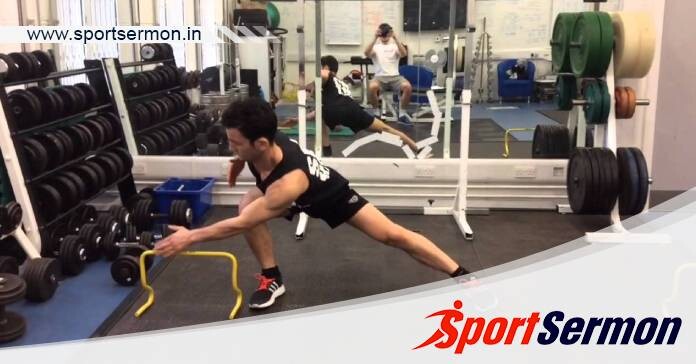Boxing Lateral Movement: Being able to move laterally well is crucial in boxing. One of the strategies you utilise to achieve the aim of hitting opponents without getting hit is lateral mobility, which is part of the sweet science. In addition to helping to set up your strikes, lateral mobility is utilised to close off the ring and keep opponents from dancing away from you. A great example of a contemporary fighter with outstanding lateral mobility is Tyson Fury.
Not only professional boxers need to practise lateral movement in boxing. Enhanced ability to move laterally increases agility and lowers the chance of injury during exercise.
Try These Boxing Exercises to Boost Your Lateral Movement
Ready to enhance your ability to boost your boxing lateral movement? Let’s examine a few of the top workouts for that:
1) Shift Laterally Using Resistance Bands
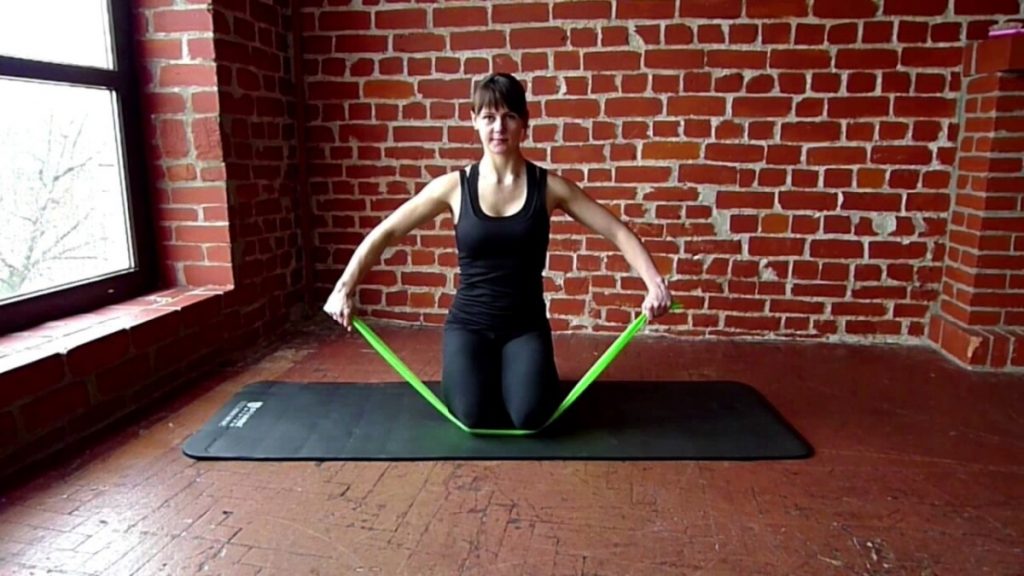
This is an excellent practice for lateral agility that raises your heart rate. You just perform a basic lateral shuffle while applying continuous pressure to your thighs using a resistance band. By working your quadriceps, glutes, and hip flexors, this exercise enhances your lateral mobility.
This is how the exercise appears:
- At the exact point where your thighs and kneecaps connect, wrap a resistance band around your legs.
- Legs somewhat wider than shoulder-width apart, knees slightly bent, take a standing position. Your toes ought to be pointed apart and outward from one another.
- Raise one leg to a height of approximately three inches above the floor, then slowly lower it away from your body and back down. The movement should now have you in a broader posture.
- Raise your second leg a few inches off the floor and pull it inside to bring it closer to your torso. After making this manoeuvre, you ought to be back in your starting position. Continue doing these motions until you either cross a predetermined distance or come to a wall.
- To finish a set, repeat the motion in the other way. Depending on your level of fitness, aim for around three to five sets.
You might also be interested in reading this: Unilateral Training Exercises for Martial Artists
2) Glass Squats with Lateral Expansion
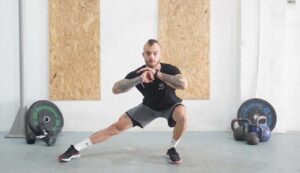
Goblet squats are similar to standard barbell squats except that you hold the weight with your hands in front of your face rather than on your shoulders. Squats primarily work your hamstrings, quadriceps, glutes, and calves. Lateral movement is added to the exercise to increase the amount of work that is done by your arms, core, glutes, and calves.
The following is a goblet squat technique that involves lateral movement:
- Place a resistance band just above the area where your knees and thighs meet. Get up, bending your knees slightly and spreading your legs approximately hip-width apart. Select a weight that you can lift and hold it in front of your face.
- Hinge your hips as you descend as though you were sitting on a chair behind you while keeping your hands on the weight. Continue until your thighs are parallel to the floor at the very least.
- Take one leg off the floor a few inches at the bottom of the squat and slide it away from you laterally. When you reach your feet in the same spot as when you originally squatted, lift up the opposite leg and bring it inside.
- To stand back up straight and explode back into an upright stance. That ends the rep. To finish a set, move in one way for six to twelve repetitions, then change directions and go in the other direction for the same amount of repetitions. Try to get three sets.
3) Lateral Lunges
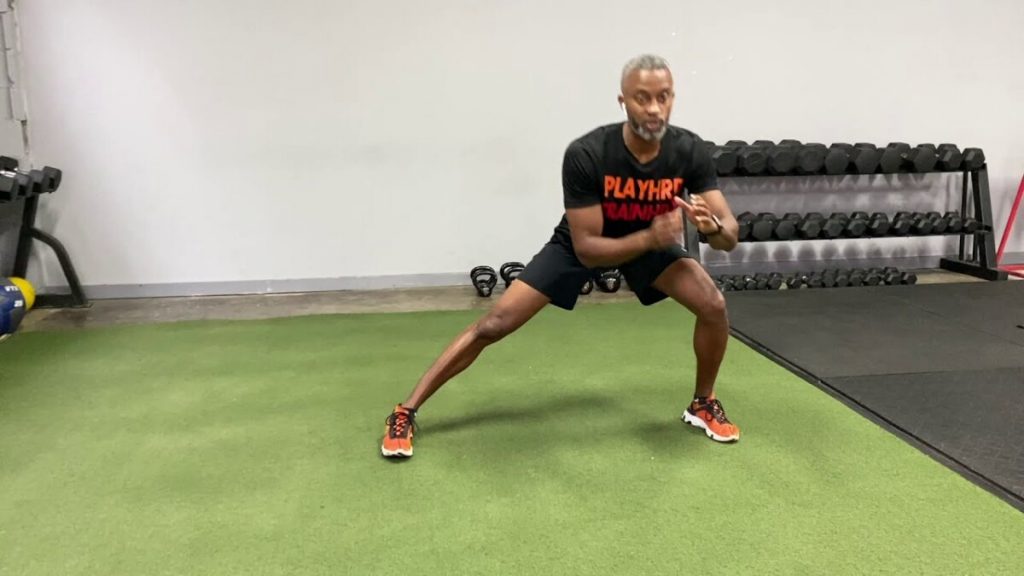
Another great exercise for building stronger stabiliser muscles that propel your lateral motions is the lateral lunge. Since most individuals concentrate more on the major muscular groups that enable acute movements, these stabilising muscles are frequently overlooked. The smaller stabiliser muscles become weaker and more prone to injury as a result.
Your knee muscles will also get stronger with lateral lunges. According to studies, one of the finest workouts for those healing from knee ligament problems is the lateral lunge. To up the intensity, you can add more weight, but if this is your first time doing this exercise, start with fewer weights that you can manage.
This is how lateral lunges are executed:
- Place yourself in the beginning posture, standing straight and keeping your feet shoulder-width apart. If you’d like, pick up some weight—a kettlebell would be ideal since it won’t strain your back while you complete lateral lunges. Hold the weight close to your body.
- With the leg that matches the arm carrying the weight, take a large lateral stride outward, bending your knee slightly as you drop your upper body onto it.
- Raise your torso back to an upright position by applying pressure to the heel of your bent leg. Repeat the motion with your other hand after shifting the weight to it. Three sets of six to twelve repetitions should be your goal.
4) Single-Leg Lateral Hops
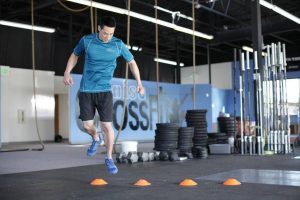
Another great exercise for strengthening your lateral mobility is the single-leg lateral hop. It improves your capacity to move laterally by making your motions crisper and faster. It operates on a similar principle to tire-mounted footwork training. Tyres or agility ladders placed strategically on the floor can be used to complete the activity.
This is how the exercise appears:
- After setting your agility ladder down, stand straight up and space your legs shoulder-width apart. Keeping your other foot outside, place one foot inside one of the ladder’s squares.
- To take the beginning posture, flex your knees slightly and bend your chest forward slightly. Move in the direction of the foot inside the agility trainer by hopping laterally across it.
- Place your inner foot all the way outside the ladder and the other way around. Repeat the exercise the other way to complete a set. Get three or five sets, if possible.
- You are welcome to move your arms during the activity.
5) Drilling Lateral Movement Using Punches
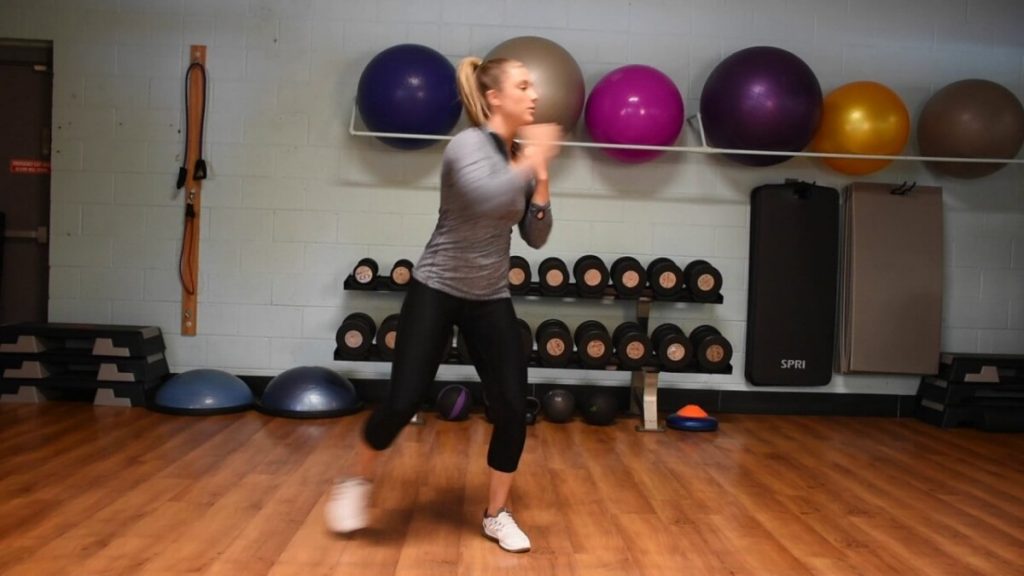
This is a basic lateral movement exercise to help you become used to shifting side to side while you punch. Your ability to stick and move will significantly increase if you incorporate this practice into your training routine. This is how the exercise appears:
- Take a fighting posture and walk to your right for a duration of thirty seconds. For 30 seconds, repeat the motion to your left.
- Take a 30-second step to your right and jab at the same time. Proceed to your left and repeat the exercise.
- For thirty seconds, take a step to your right and execute a jab-cross combination. Proceed to your left once again.

